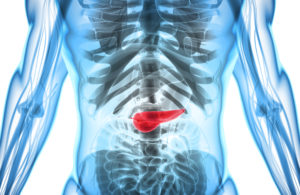
To address the challenge of accurately diagnosing chronic pancreatitis (CP), researchers at Brigham and Women’s Hospital (BWH) have introduced a novel prediction model that combines findings of endoscopic ultrasound (EUS) with pancreatitis-specific behavioral risk factors.
“We asked, can we come up with a more objective way to diagnose chronic pancreatitis?” says Linda Lee, MD, a gastroenterologist in the Division of Gastroenterology, Hepatology and Endoscopy at BWH. “If radiological findings are not obvious for chronic pancreatitis, how do we clinch the diagnosis?”
While diagnosis of CP is relatively easy in severe cases (when CT shows calcifications throughout the pancreas, for example), it can be difficult when the disease is in early to mild forms. The pancreas appears normal in many patients with chronic upper abdominal pain, and pancreatic function tests (the non-histologic gold standard for determining CP) are time-consuming and are not widely used.
Accurately diagnosing CP is essential to avoid mislabeling people whose chronic abdominal pain has other sources and to enable appropriate care and follow-up of patients who do have CP. This has implications for not only symptomatic management but also monitoring other potential disease sequelae including diabetes, osteoporosis and pancreatic cancer.
Dr. Lee and colleagues at BWH, Ohio State University, and the Department of Clinical Research at CareFusion in San Diego retrospectively studied 176 patients from BWH and Cleveland Clinic Foundation. All patients had both EUS and endoscopic pancreatic function test (ePFT) either simultaneously or within three months of each other for suspected CP, with ePFT results used as the standard for diagnosing CP. Data from the EUS and ePFT findings were collected as well as demographic and behavior data including age, gender, race, smoking and alcohol consumption.
The researchers created a risk score based on four variables of which three were findings during EUS: alcohol or smoking status, the number of parenchymal abnormalities, the number of ductal abnormalities, and calcifications. Risk scores for the study patients ranged from 0 to 32. Of patients who scored four or less, only 10.7 percent had abnormal ePFTs. Among patients with scores of 20 or great, 92 percent had abnormal ePFTs. This led the researchers to conclude that the model predicts abnormal pancreatic secretory function by incorporating and weighting patient-specific pancreatitis behavioral risk factors and EUS findings.
In clinical practice, this information can help guide whether an ePFT (a 45 to 60-minute procedure) is needed beyond the significantly shorter EUS.
“Our risk score is also practical in guiding the evaluation of suspected CP,” Lee and co-investigators wrote when their research was first published in Pancreas in March 2017. Scores at or below four suggest ePFT needn’t be performed because the risk of CP is low, while scores at or above 20 suggest PFT can be avoided because of the high likelihood of an abnormal result.
For patients with scores in the middle, between five and 19, pancreatic function testing may be performed to further assess for exocrine insufficiency, the authors noted.
“So many patients are mislabeled with chronic pancreatitis when they very well might have something else going on,” says Dr. Lee, associate director of endoscopy at BWH. Thus, patients with debilitating pain and assumed chronic pancreatitis may bounce in and out of Emergency Departments, often receiving narcotics.
“Mislabeling these patients brings on a whole host of problems,” Dr. Lee cautions. While improved imaging studies and molecular markers from pancreatic fluids or even blood and urine eventually may offer better diagnostic tests in the future, she says, “it’s important for now to diagnose these patients the best we can with tools currently available.”